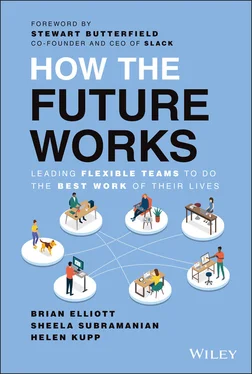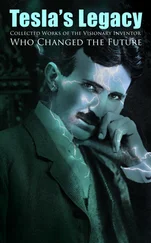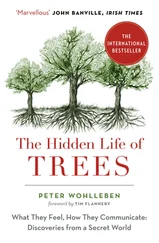Brian Elliott - How the Future Works
Здесь есть возможность читать онлайн «Brian Elliott - How the Future Works» — ознакомительный отрывок электронной книги совершенно бесплатно, а после прочтения отрывка купить полную версию. В некоторых случаях можно слушать аудио, скачать через торрент в формате fb2 и присутствует краткое содержание. Жанр: unrecognised, на английском языке. Описание произведения, (предисловие) а так же отзывы посетителей доступны на портале библиотеки ЛибКат.
- Название:How the Future Works
- Автор:
- Жанр:
- Год:неизвестен
- ISBN:нет данных
- Рейтинг книги:5 / 5. Голосов: 1
-
Избранное:Добавить в избранное
- Отзывы:
-
Ваша оценка:
- 100
- 1
- 2
- 3
- 4
- 5
How the Future Works: краткое содержание, описание и аннотация
Предлагаем к чтению аннотацию, описание, краткое содержание или предисловие (зависит от того, что написал сам автор книги «How the Future Works»). Если вы не нашли необходимую информацию о книге — напишите в комментариях, мы постараемся отыскать её.
when
where
How the Future Works: Leading Flexible Teams to Do The Best Work of Their Lives
How the Future Works
How the Future Works
How the Future Works — читать онлайн ознакомительный отрывок
Ниже представлен текст книги, разбитый по страницам. Система сохранения места последней прочитанной страницы, позволяет с удобством читать онлайн бесплатно книгу «How the Future Works», без необходимости каждый раз заново искать на чём Вы остановились. Поставьте закладку, и сможете в любой момент перейти на страницу, на которой закончили чтение.
Интервал:
Закладка:
Customer engagementcan be positively impacted as well. At Slack, team members found that connecting remotely made it easier to meet with more customers during the day, as well as get time on an executive's calendar since videoconferencing often felt less formal than an in-person meet. Where they used to be able to visit one client a day, sales staff say they can now do three videoconferences in a day. Salesforce found similar benefits: Their Zoom customer calls had 25% higher C-level attendance and their sales teams reported getting back two weeks of selling time due to their virtual sales kickoff taking up less time on their calendars than previous in-person ones.
Another way that flexibility builds better results is by enabling diversity, which, as is now well-known, has a positive impact on results. There are numerous studies that support this, including one done by Boston Consulting Group in 2017 that linked diversity and profitability: Companies with above-average diversity among their executive teams saw EBIT (Earnings Before Interest and Taxes) margins that were 9 percentage points higher than those who were below average. Even more striking, those same companies reported innovation revenue that was 19 percentage points higher than that of companies with below-average leadership diversity—45% of total revenue versus just 26%. 13Diverse companies also tend to grow faster, be more innovative and adaptable, have higher cash flow, and even be better at building leaders. 14
In spite of the great potential of diverse organizations, especially in solving today's most complex problems, many leaders struggle with the friction that comes with diverse teams. Flexible work, while not a total solution, is a tool that can help for a variety of reasons. For one, about 60% of the Black labor force in the US is located in the Southeast, compared to only one-third of private sector jobs. 15Location flexibility allows companies to attract employees who live far from their offices. We have already seen how this benefited Dropbox, who saw a 16% increase in diverse candidates. As a result of the transition to flexible work, Slack has hired one-third more remote-based historically discriminated employees than office-based.
Future Forum research shows that large majorities of Black, Hispanic, and Asian respondents in the US all want flexible work—which means it can have a positive impact on recruiting and retention among these groups. The same is true for women, and we have already talked about some of the benefits to working moms and other caregivers who are disproportionately female. Flexible work can also offer a better experience to groups that have been historically discriminated against. For example, Black employees who work remotely have a higher sense of belonging than those who work in the office. 16There are likely a variety of reasons for this. As Stanford professor, Brian Lowery, explains, office-centric work can perpetuate outsider status: “Black employees can experience stress associated with working in a predominantly white workplace, which contributes to a lower sense of belonging. Importantly, it might not be work activities per se driving these effects, but all of the big and small social interactions that make up much of our work days.” 17
Finally, it's worth noting the impact flexible work can have on your bottom line. Retaining employees saves companies money. Increasing productivity makes companies more money. Decreasing the need for costly expenditures on things like office buildings in expensive urban centers and travel to and from different client and company locales frees up resources that can be put to better use elsewhere—on those things that will drive the outcomes you want. Think of it this way: Would you rather invest money in the seats your employees occupy or in the things that will enable those employees to do their best work, no matter where they sit?
What's Getting in the Way
Given all the potential benefits to flexible work, one has to ask: Why isn't everyone doing this?
At a Glance: The Benefits of Flexible Work
Flexible work helps companies win the battle for talent, engage employees, and build better resultsby having a proven positive impact in the areas of:
| Recruiting | Innovation |
| Retention | Customer Engagement |
| Productivity | Diversity |
| Creativity | Your Bottom Line |
One answer is that status quo bias is real, and our default instinct is often to return to old ways of doing things because that's what we know and that's what we're comfortable with. 18After all, that was what got us and our organizations here in the first place. If it was good enough then, why isn't it good enough now? Slack CEO Stewart Butterfield talks about this resistance to change in terms of meetings. Despite the fact that just about every executive he's ever talked to about the subject believes their organization has too many meetings and could gain a lot by being more efficient about how they are structured and run, “They literally do nothing to try to make the improvements because it's not what they're used to and they don't have good ideas about how to get it done.” It's an issue we're tackling at Slack because too many meetings inhibits schedule flexibility, which is central to how we want to work and something we all need to get a lot better at managing.
Another answer is that flexible work models haven't always been successful. While the pandemic accelerated the need for and the adoption of flexible work options, various versions of it existed long before. Pre-pandemic there were a number of high-profile companies that tried it, only to reverse course when a new CEO came on board or they didn't see the results they were looking for. But many of those early attempts failed before new technologies changed the landscape of what's possible. The availability of broadband connection, SaaS tools, and the consumerization of IT have made things possible that simply weren't before, and the pandemic sped up advancements even further.
One of the biggest reasons why flexible work hasn't always worked in the past, and can still fail today, is because companies don't always get it right. They often fail on two fronts:
The What: Too many people don't fully understand what flexible work could or should mean for them, particularly the crucial importance of schedule flexibility.
The How: Too many people don't understand how to execute it successfully.
This book is going to show you how to do both.…
The What: Digital-First
As noted above, there are different versions of flexible work, and different companies have given different names to their flexible work strategies, as you'll see throughout this book. But there is a version of flexible work that we advocate based on our research and experience: Digital-First. It is the backbone of flexible work, and you need to adopt a Digital-First approach in order for flexible work to really work.
What do we mean by Digital-First? Let's start by defining what it isn't:
Digital-First is not the office-centric way of the past.
Digital-First is not just about location flexibility.
Digital-First is not a mandate about how many days a week people can work from home.
Digital-First does not mean never in person, or that all work gets done remotely.
Digital-First means making the switch from a mode of operations where digital technologies supplemented in-person communication as a way of getting work done, to one where in-person supplements the digital in order to build a more connected and inclusive way of working for everyone. This requires a switch in mindset. Companies can still have a headquarters, but it's going to primarily be a digital HQ, supplemented by physical office space. Companies can still build a connected and collaborative culture, but it's going to be built largely in digital forums, supplemented by in-person connections. And perhaps most importantly, Digital-First means embracing and prioritizing a truly flexible way of working, one in which people are given the freedom of choice—in terms of both when they work and where they work—in order to unlock their potential and enable them to perform at their best.
Читать дальшеИнтервал:
Закладка:
Похожие книги на «How the Future Works»
Представляем Вашему вниманию похожие книги на «How the Future Works» списком для выбора. Мы отобрали схожую по названию и смыслу литературу в надежде предоставить читателям больше вариантов отыскать новые, интересные, ещё непрочитанные произведения.
Обсуждение, отзывы о книге «How the Future Works» и просто собственные мнения читателей. Оставьте ваши комментарии, напишите, что Вы думаете о произведении, его смысле или главных героях. Укажите что конкретно понравилось, а что нет, и почему Вы так считаете.












